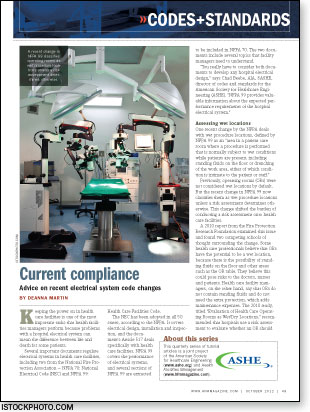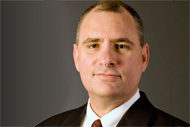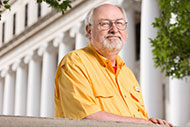 Keeping the power on in health care facilities is one of the most important tasks that health facilities managers perform because problems with a hospital electrical system can mean the difference between life and death for some patients.
Keeping the power on in health care facilities is one of the most important tasks that health facilities managers perform because problems with a hospital electrical system can mean the difference between life and death for some patients.
Several important documents regulate electrical systems in health care facilities, including two from the National Fire Protection Association — NFPA 70: National Electrical Code (NEC) and NFPA 99: Health Care Facilities Code.
The NEC has been adopted in all 50 states, according to the NFPA. It covers electrical design, installation and inspection, and the document's Article 517 deals specifically with health care facilities. NFPA 99 covers the performance of electrical systems, and several sections of NFPA 99 are extracted to be included in NFPA 70. The two documents include several topics that facility managers need to understand.
"You really have to consider both documents to develop any hospital electrical design," says Chad Beebe, AIA, SASHE, director of codes and standards for the American Society for Healthcare Engineering (ASHE). "NFPA 99 provides valuable information about the expected performance requirements of the hospital electrical system."
Assessing wet locations
One recent change by the NFPA deals with wet procedure locations, defined by NFPA 99 as an "area in a patient care room where a procedure is performed that is normally subject to wet conditions while patients are present, including standing fluids on the floor or drenching of the work area, either of which condition is intimate to the patient or staff."
Previously, operating rooms (ORs) were not considered wet locations by default. But the recent change in NFPA 99 now classifies them as wet procedure locations unless a risk assessment determines otherwise. This change shifted the burden of conducting a risk assessment onto health care facilities.
A 2010 report from the Fire Protection Research Foundation examined this issue and found two competing schools of thought surrounding the change. Some health care professionals believe that ORs have the potential to be a wet location, because there is the possibility of standing fluids on the floor and other areas such as the OR table. They believe this could pose risks to the doctors, nurses and patients. Health care facility managers, on the other hand, say that ORs do not contain standing fluids and do not need the extra protection, which adds maintenance expenses. The 2010 study, titled "Evaluation of Health Care Operating Rooms as Wet/Dry Locations," recommended that hospitals use a risk assessment to evaluate whether an OR should be classified as a wet or dry location.
Despite evidence that not all ORs are wet procedure locations, members of the NFPA voted to accept the shift, and ORs are now considered wet procedure unless a risk assessment determines otherwise.
The change may cost some hospitals resources if they need to provide special protection against electric shock hazards such as the installation of isolated power systems or ground-fault circuit interrupters (GFCIs). ASHE stresses to hospital facilities managers that the key to achieving compliance with this new requirement — and protecting scarce resources of time and money — is conducting a risk assessment.
NFPA is working on guidelines for a risk assessment to determine whether ORs should be considered wet locations. Meanwhile, ASHE has made a document available to its members explaining how to conduct an OR risk assessment at www.ashe.org/resources/asheinsider/2012/spotlight_120313.html. A brief synopsis of the process includes the following steps:
Step 1. Form a risk assessment group to develop a process for evaluating ORs.
Step 2. The risk assessment group gathers information to determine which surgical procedures qualify as wet procedures. Rooms in which wet procedures are never performed do not need a more in-depth study.
Step 3. When a more in-depth risk assessment is needed to determine whether an OR should be classified as a wet procedure location, evaluate the condition of the room during surgical procedures. Maintaining a log for each OR can be done in several ways — including having OR personnel maintain a log for each procedure with a checkbox for when wet conditions occur or by having the environmental services department track the number of times they are called to clean up fluid or spills from ORs.
Step 4. If the risk assessment group determines the facility has wet procedure locations, protect those ORs with isolated power or ground-fault interrupters.
Step 5. If the facility has wet procedure locations, assess whether staff would be in danger of electrical shock from standing in a pool of liquid and touching a faulty medical device.
Some ORs are more likely than others to be classified as wet procedure locations, says Krista McDonald Biason, P.E., associate vice president at HGA Architects and Engineers in Minneapolis.
For example, hip replacements require a lot of irrigation, which can mean a wet location regardless of how neat the surgeon is. ORs at teaching hospitals may be determined wet procedure locations because students are learning the proper amount of irrigation and haven't yet perfected techniques. "Teaching hospitals need to realize they're more than likely going to have some wet procedure locations," she says. "Students haven't had as much experience."
It is also important to review possible mitigating factors with a risk assessment, such as scavenging systems, mats and table drains.
If a wet procedure location exists, the facility must choose between GFCIs and isolated power, explains Jim Degnan, P.E., LEED AP, principal and chief electrical engineer at the Lynnwood, Wash.-based technology consulting firm Sparling.
If a ground fault occurs on a GFCI circuit, the GFCI will interrupt the power and the procedure must be able to tolerate the interruption or have an appropriate contingency plan. Isolated power systems will not interrupt power if the electrical system has a single ground fault; they will only send out an alarm, which can allow for finishing the procedure. However, once the first fault occurs there is always the possibility that a second fault could leave the isolated circuit without power.
GFCIs are a low-cost solution and easily can be retrofitted into most facilities, Degnan says, while isolated power systems are expensive, require extensive amounts of built-in equipment and cannot be retrofitted easily.
Selective coordination
Another important part of code requirements surrounding electrical systems is selective coordination.
The NEC requires health care facilities to coordinate the essential electrical system to avoid cascading outages — basically keeping smaller problems like a fault on a single circuit from becoming a larger issue, such as taking out entire panelboards.
Supporters say that selective coordination localizes and minimizes the extent of power interruptions and is a key safety element, especially in facilities where it is essential to keep power running. But coordinating electrical systems in this way can be expensive, and critics have questioned the necessity of this requirement. Critics also say that selective coordination can make maintaining electrical equipment more dangerous because working on live electrical equipment can expose people to high arc-flash hazards.
There may be a bit of conflict over this issue within NFPA itself. The NFPA Standards Council acknowledged in a 2011 memo rejecting an appeal that there was disagreement over whether the issue of selective coordination should be handled by NFPA 99 or the NEC. The council said in a 2011 decision that it has been aware of coordination issues between the NEC and other NFPA documents with respect to performance requirements for certain areas of emergency systems. The council said that based on its own assessment, along with input from a task group on intercommittee coordination, it had "no difficulty in concluding that the prevention of cascading outages (achieving selective coordination) is a performance requirement belonging to NFPA 99, not an installation requirement within the jurisdiction of the NEC."
NFPA 99 allows cascading operation of overcurrent devices during the first 0.1 seconds of a fault. But the NEC requires overcurrent devices to be selectively coordinated with supply side overcurrent protective devices without delay, which experts say is significantly harder to achieve than selective coordination to 0.1 seconds.
The code development cycle for NFPA 70 follows NFPA 99. This means that the current edition of the NEC does not include extracted text from the latest edition of NFPA 99, so the NEC currently doesn't allow cascading of overcurrent devices for the essential electrical system in a hospital.
As a charging document, NFPA 99 should govern in this case, but this is often overlooked by designers and authorities having jurisdiction (AHJs), Beebe says. Health facility engineers are watching the current revision cycle of the NEC to ensure that the electrical committee picks up the change from NFPA 99.
"It was kind of like the cart before the horse here," Degnan says. "Now the NEC is almost going to have to relinquish a little bit. We'll just have to see what happens."
Those on the other side of the argument, however, are hoping for a different end to the turf battle. They hope selective coordination remains in the NEC even though the standards council states that NFPA 99 should take the lead on this issue, and they also want NFPA 99 to include selective coordination.
Regardless of how the codes came to be — and what's in store for them in the future — hospitals still must determine how they are going to comply with today's selective coordination requirements. Biason, with HGA Architects and Engineers, says selective coordination can be a tricky area because of what's required by code and how each AHJ implements it. "It can have a significant cost impact," she says.
For existing health facilities, replacing everything to ensure selective coordination is not often a realistic answer, Biason says. The key is working with AHJs to set up long-term plans that are more reasonable. "Most facilities have been sitting there for 20, 30 or 40 years," she says. "You do the best you can to make it better and safer working with electrical inspectors and AHJs."
Another problem is that hospitals or contractors putting out requests for proposals for selective coordination may not get the information they need. Some bidders do not factor in the costs of selective coordination in their estimates, making it hard to compare apples to apples.
"You will get people bidding on projects and they won't take selective coordination into account even though you require it," she says. "That's quite a dilemma."
Deanna Martin is senior communications specialist with the American Society for Healthcare Engineering. She can be reached atdmartin@aha.org.
| Sidebar - NEC development process |
| The 2014 edition of National Fire Protection Association's NFPA 70: National Electrical Code (NEC) is currently in the development process. Following are the major stages:
To submit a proposal before the Oct. 17 deadline, download a comment form for the 2014 edition of NFPA 70 from the NFPA's website at www.nfpa.org/AboutTheCodes/AboutTheCodes.asp?docnum=70&tab=nextedition. |





